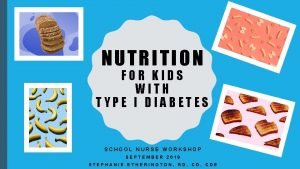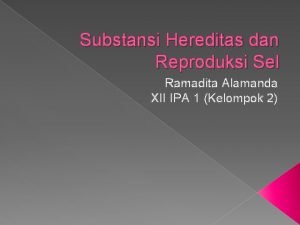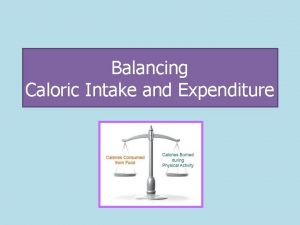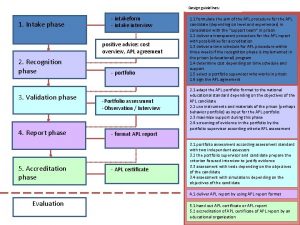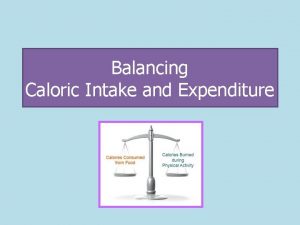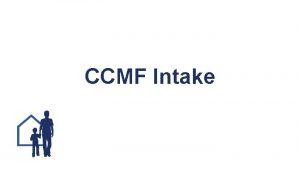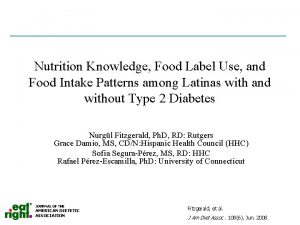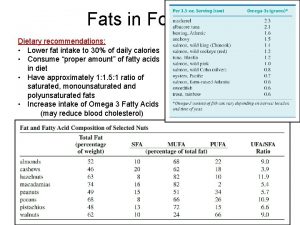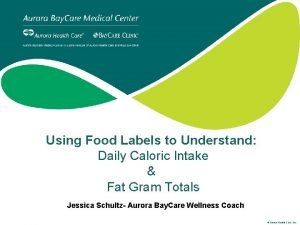Alamanda College Food Intake Food intake is the


















- Slides: 18

Alamanda College

Food Intake Food intake is the total amount of energy that you get from all of the food and the liquids that you consume. It varies from person to person, but there are general guidelines to help you determine how much you need to eat.

How Much Should I Eat? There are plenty of websites that give you a general guide line of how much you should eat. It really depends on what outcomes you want to achieve. If you want to maintain your weight you can eat a little bit more, if you want to lose weight then you need to eat a little bit less, and if you want to extreme diet then you have to cut everything out. http: //www. freedieting. com/tools/calorie_calculator. htm

Average Daily Caloric Intake 7 -10 11 -14 15 -18 19 -50 Female 1740 1845 2110 1940 Male 1970 2220 2755 2550 http: //www. vitalhealthzone. com/nutrition/diets/recommended_calorie_intake. php Remember these are just general guidelines. If you are active then you need to consume more calories, if you are sedentary (less active) then you need to consume less calories. Question: Why do males need to consume more calories than females?

Small Differences Add up to a Big Difference If every day you consume 50 calories more than you burn off. That’s 350 calories extra per week. 50 x 7 = 350 cal If you do that every week for a year. 350 x 52 = 18200 cal There’s about 7, 700 cal per kilo of body fat. 18200 ÷ 7700 = 2. 36 kilos. So if you did that over 10 years, you would gain 23. 6 kilos. 20 years, you would gain 47. 2 kilos, over 30 years you would gain 70. 8 kilos. So what is 50 calories? 1 Kiwi or 2 Hersey’s Kisses or half a pack of a small Smith’s chips

How many calories in food? By law, in Australia, every packaged food needs to have a food label. The food label breaks down all of the nutritional facts of the food it contains.

How to Read Food Labels If you follow all of these steps reading food labels is very easy. First thing to look at is the caloric content of the food item. So this item has 251 calories, which is about a tenth of what an adult male should be eating in a day.

How to Read Food Labels 2) Second thing to look at is serving size. By law, food packaging companies need to have a food label, but they have little “tricks” to actually make an unhealthy item seem healthy. So be very careful when analyzing food labels and pay attention to serving size! This package of chips has 120 cal per serve, but there’s 10 serves in the package, so there’s actually 1200 kcal in the whole package not 120.

How to Read Food Labels If you follow all of these steps reading food labels is very easy. Third thing to do is analyse the 3 parts of food. All food is made out of 3 parts: fat, carbohydrates and protein. All three things do different things for our body and we need them all. Fats help to store “back up” energy, it also helps to provide protection for our vital organs. It also helps to build hormones and chemicals in our bodies. Carbohydrates gives us immediate energy. Proteins helps us build muscles.

How to Read Food Labels If you follow all of these steps reading food labels is very easy. Third thing to do is analyse the 3 parts of food. A quick way to analyze the content of the food is to look at the % daily value. Remember everyday you should be eating 100% of the 3 parts of food. So this food item contains 15% of the total fat that we should be eating. It also contains 13% of the carbohydrates we should be eating. Most food labels won’t have a % daily value for protein, because protein intake varies from person to person. Some body builders need more protein to help build muscles, sedentary people won’t need as much protein because they won’t need to build muscles.

How to Read Food Labels If you follow all of these steps reading food labels is very easy. Last thing you need to analyze is Sodium content. Another word for sodium is salt.

Why is Salt Bad? Salt has 1 very bad property. It attracts water. Before Salt After

So What Happens when Salt is in the Body A normal blood vessel is fine because the heart doesn’t have to work too hard. (only 4 arrows of pressure). Now when you consume salt, the salt goes directly into your blood stream. Remember one bad thing about salt is that it likes to attract water. So your blood vessels have to expand in order to take in the extra water. Instead of using only 4 arrows of pressure, the heart now has to work harder in order to pump the blood around the body. (8 arrows) Normal Blood Vessel Your heart is a muscle, so what happens when your muscles work too hard? Blood Vessel with salt

How to Read Food Labels If you follow all of these steps reading food labels is very easy. Last thing you need to analyze is Sodium content. Another word for sodium is salt. So in this case it only has 3% of your daily salt value, so it’s not too bad.

How to Read Food Labels If you follow all of these steps reading food labels is very easy. So let’s analyze this food item. Using color coding makes it easier to determine if it’s good or bad. Amount Total DI% Calories 251 1845 13. 5% Serving Size 53 g Fat 9. 5 g 70 g 13. 6% Carbohydr ates 38. 4 g 310 g 12. 4% Protein 1. 9 g 50 g 3. 8% Sodium 70 mg 2300 mg 3%

Amount Calories Total 1845 Serving Size Fat 70 g Carbohydrate s 310 g Protein 50 g Sodium 2300 mg Sugar 90 g DI%

Food Item So what was the food item?

Food Analysis A Mars bar has 4 reds, 1 amber and 1 green, so this food item is definitely something that isn’t healthy to eat. Your assessment task for this term is to look for a food label and you’re going to do a food label analysis. You will be marked on accuracy and description of the food analysis.
 Diabetes diet plan
Diabetes diet plan Hát kết hợp bộ gõ cơ thể
Hát kết hợp bộ gõ cơ thể Slidetodoc
Slidetodoc Bổ thể
Bổ thể Tỉ lệ cơ thể trẻ em
Tỉ lệ cơ thể trẻ em Chó sói
Chó sói Tư thế worm breton
Tư thế worm breton Chúa yêu trần thế
Chúa yêu trần thế Môn thể thao bắt đầu bằng chữ đua
Môn thể thao bắt đầu bằng chữ đua Thế nào là hệ số cao nhất
Thế nào là hệ số cao nhất Các châu lục và đại dương trên thế giới
Các châu lục và đại dương trên thế giới Công thức tính thế năng
Công thức tính thế năng Trời xanh đây là của chúng ta thể thơ
Trời xanh đây là của chúng ta thể thơ Mật thư anh em như thể tay chân
Mật thư anh em như thể tay chân Phép trừ bù
Phép trừ bù độ dài liên kết
độ dài liên kết Các châu lục và đại dương trên thế giới
Các châu lục và đại dương trên thế giới Thể thơ truyền thống
Thể thơ truyền thống Quá trình desamine hóa có thể tạo ra
Quá trình desamine hóa có thể tạo ra
